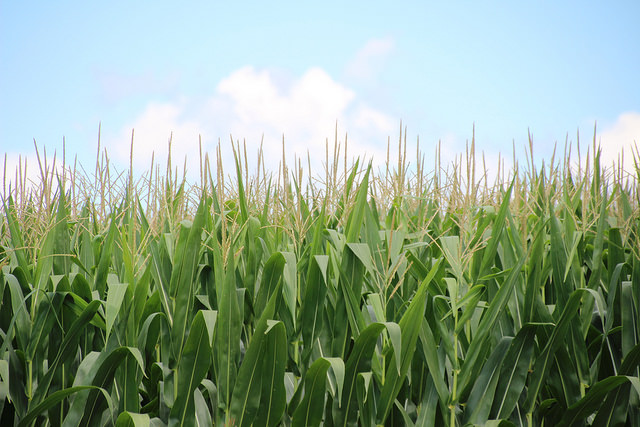Another July 4 has come and gone, and that old saying about a farmer’s corn this time of year (“knee high by the Fourth of July”) is a thing of the past too. Nowadays, the corn plants in many fields around the country are more like waist-high (or even taller!) in early July, and growing fast. But while a bumper harvest of corn seems like a good thing, the dirty little secret in corn country is that a glut of the stuff is wreaking havoc on farm families, on rural economies, and on all of us as taxpayers.
Earlier this year, the US Department of Agriculture (USDA) released its annual spring prediction about how much corn farmers would plant. The estimate was enormous: nearly 94 million acres‘ worth. Now, based on an extensive national survey in late spring after the crops started growing, the USDA confirmed last week that farmers met and even exceeded that prediction a bit. On this point, the department’s press release nearly glows:
U.S. corn growers also benefited from the excellent field conditions this year, increasing their acreage from last year by 7 percent to 94.1 million acres, making it the third highest corn planted acreage since 1944. Growers expect to harvest 86.6 million acres for grain. If realized, this will be the third highest acres harvested for grain since 1933.
94 million acres. A near-record. But have farmers really benefited?
Corn, corn, and more corn…
My colleague Ricardo Salvador has written about the slow explosion of corn on the American landscape over the last 80 years. As he noted, the United States today simply grows too much corn. (And for that matter, too many soybeans—the USDA report indicates that farmers planted a record-high 83.7 million acres of soy this past spring, up 1 percent from last year.)
Agribusiness companies and their lobbyists trumpet these enormous plantings and the resulting harvests (like 2014’s record harvest of 14.2 billion bushels of corn!) as evidence of the success of our current industrialized farming system. Never mind that corn and soybeans aren’t really food—at least, that’s not how most of them are grown and used. Far from the mythical “feeding the world,” these crops are mostly fattening livestock, filling gas tanks (with corn ethanol and soy biodiesel), and producing a bevy of ingredients for the processed junk food that is making Americans sick.
But there’s more. Farmers are losing their shirts on these crops, especially corn.
It’s classic supply and demand, Econ 101. Because of the oversupply, the price of corn in particular has plummeted, to the point where farmers are expected to lose money on each acre planted this year, especially with land, seed, and chemical input costs still high. But farmers are trapped in the system, as a recent Reuters story reveals:
Illinois farmer Dave Kestel said he would be lucky to break even on the corn he planned to start planting in April on his farm in Manhattan, an hour’s drive southwest from Chicago. He aims to plant roughly the same area as last year, about 500 acres (202.34 hectares), despite lower prices.
“It’s a vicious circle, but you still do it,” Kestel said, about planting corn.
In April, Harvest Public Media reported on the conundrum under the telling headline, “Midwest expected to be awash in corn again”:
Prices for staples like corn and soybeans have been sliding in recent years thanks, in part, to oversupply. Another gigantic harvest of the Midwest’s most important crop could spell further down times for the farm economy. The Federal Reserve Bank of Kansas City expects farm income to be down, according to a report by the bank’s Nathan Kauffman.
“The USDA projects real net farm income to be slightly less than a year ago; that projection would mark the second-lowest farm income total in more than 30 years,” Kauffman wrote in the report.
Many Midwest farmers are stuck in a bind.
And just last month, there was this news coverage about an obscure report from Kansas confirming the crisis for farmers in that state:
The average net farm income for farmers in Kansas…plummeted in 2015 to just $4,568, according to a report released this week by the Kansas Farm Management Association (KFMA). The figure is less than 5 percent of the previous year’s average of $128,731.
The 2015 KFMA report measures the average net farm income of its members, which include about 10 percent of Kansas farmers that gross more than $100,000 annually, and found the lowest average level of nominal net farm income in Kansas since 1985.
Yes, you read that right. Net farm income in Kansas plunged by 96 percent last year. And all this is bad not just for farmers themselves but for farm communities, which are also suffering as a result of farmers’ economic woes.
A new approach to farming—and a national food policy—is needed
So how might America’s farmers get out of this bind?
Interestingly, none of the news articles referenced above ever mentions another crop besides corn and soy. It’s as though those are the only choices American farmers have. And in truth they pretty much are, but only because our nation’s farm policies overwhelmingly support and encourage production of these and a few other commodity crops.
As I wrote way back in 2012, research from the heart of corn country—Iowa State University—shows that if farmers there were to diversify, their farms would be more profitable. Since then, UCS has also shown that if farmers who currently grow mostly corn and soy were to shift even some of their acreage to fruits and vegetables, we’d see health and environmental benefits. And that if Iowa farmers (for example) were better connected to food buyers at local grocery stores, restaurants, and hospitals, farm communities would prosper. Later this year, we’ll release new analysis showing how US taxpayers and others would also benefit if farmers grew less corn.
But of course such a change will require new and updated public policies that provide appropriate incentives and support for farmers. More reasons for the next president to take up comprehensive food and farm policy reform as a priority.

